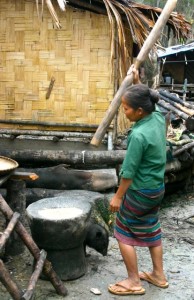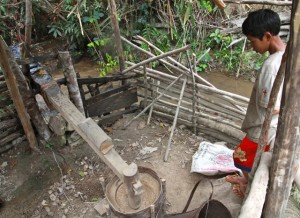Project Sekong 2012: Will two rice crops a year mean double the work for women who pound and winnow the grain?

In some communities women use arm power to pound rice. In others, leg power. But all over Laos its women and girls who do most of the work involved in getting rice from the field to the dinner table.
Report 27
Hill rice is grown on the steep hillsides that have had all natural vegetation removed through the age-old practice of “slash and burn” or “swidden” agriculture. The slopes are too steep to permit standing water; hill rice plants depend on sufficient rainfall during the growing season and, as a consequence, yield just a single annual crop.
Here in Sekong people grow paddy rice, a semi-aquatic plant that requires standing water at a critical stage in its life cycle. Once the new irrigation ditches are dug and water starts to flow from mountain streams to parched paddy fields villagers in Dak Door and other communities we are serving will be able to cultivate a second annual crop.
Whether a family grows hill or paddy rice, its mostly female labor that gets the crop from the field to the dinner table. Men and women, boys and girls work together to harvest the mature plants, and both genders share the work of threshing the grain. But, the daily task of pounding rice and then winnowing it to remove the hulls is performed almost universally by women and girls.
Depending on the ethnic group, there are two principal ways of knocking hulls from rice. Some groups employ arm strength; women lift a stout, yard-long, hardwood pestle overhead and then drop it into a rice-filled mortar. Other ethnic groups favor using leg strength to lift and drop a log that’s positioned seesaw like over a mortar.
The leg-powered log takes greater effort, the log being considerably heavier than the arm-powered pestle. Often, I see two or three girls working together, stepping rhythmically onto the end of the log to lift it above the rice. Once, I saw a small girl doing the job alone. Since she was too light to lift the log by her weight alone, her parents had outfitted her with a backpack full of rocks that significantly added heft to her end of the log.

In Dak Door villagers employ water power to lift the log that pounds rice. This innovation has arrived just in time since many families anticipate doubling their rice crop when irrigation becomes available.
Here in Dak Door, villagers have taken advantage of water coursing down the hillside to create water-powered rice pounders. They are similar to the log pounders but rather than a woman or girl applying her weight to the log, there is a bucket that catches water piped from a stream. The weight of the water-filled bucket lifts the log. When the log is fully raised, the bucket spills the water and the log drops with force into the rice-filled mortar below.
The question that comes to mind is how will village women reallocate their time now that rice pounding is removed from their daily list of chores. Will girls have more opportunity to attend school? Will their mothers enjoy a few minutes of well-earned leisure? It’s too soon to tell. These water-powered pounders are an innovation that was just introduced here this year. But, their is well-timed. If the irrigation project we’re working on succeeds in doubling the rice harvest there will be more grain than ever for women to process.

I’m not familiar with the gender culture in Dak Door, so must ask: Why don’t the women train the men to pound rice, too?
You know the old saying “Man’s work is sun to sun. Women’s work is never done”. In Laos, there are gender issues that greatly favor men and boys. I’m working on a future blog that discusses women’s work. IMHO: women do far more labor then men and people doing community development need to consider this fact when they bring new economic opportunity to a village. What more can be piled on the backs of women and girls?